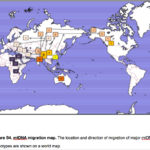
World Science en Route from Out-of-Africa to Out-of-America: First Stop is Out-of-Asia
bioRxiv doi: https://doi.org/10.1101/101410 Yuan, Dejian, Xiaoyun Lei, Yuanyuan Gui, Zuobin Zhu, Dapeng Wang, Jun Yu, and Shi Huang Modern Human Origins: Multiregional Evolution of Autosomes and East Asia Origin of Y and mtDNA Recent studies have established that genetic diversities are mostly maintained…

Make Out-of-America Great Again: Humans in the New World at 24,000 YBP
PLoS ONE 12(1): e0169486. doi:10.1371/journal.pone.0169486 Earliest Human Presence in North America Dated to the Last Glacial Maximum: New Radiocarbon Dates from Bluefish Caves, Canada Burgeon, Lauriane, Ariane Burke, and Thomas Higham The timing of the first entry of humans into…

Molecular Variance Across Genetic Systems in Modern Humans and Their Kinship Structures
Gisele Horvat has kindly pointed me to this new pre-print. This post is cross-posted at www.kinshipstudies.org. Global patterns of sex-biased migrations in humans Chuan-Chao Wang, Li Jin, Hui Li. Abstract A series of studies have revealed the among-population components of…
Congenital Anomalies, Kinship Systems and Pleistocene Demography
PLoS ONE 8(3): e59587. doi:10.1371/journal.pone.0059587 An Enlarged Parietal Foramen in the Late Archaic Xujiayao 11 Neurocranium from Northern China, and Rare Anomalies among Pleistocene Homo Xiu-Jie Wu,Song Xing, and Erik Trinkaus. We report here a neurocranial abnormality previously undescribed in…
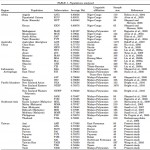
Is Taiwan to Austronesians what America is to Modern Humans?
American Journal of Physical Anthropology 150 (4): 551–564, April 2013 Ascertaining the Role of Taiwan as a Source for the Austronesian Expansion Sheyla Mirabal, Alicia M. Cadenas, Ralph Garcia-Bertrand, and Rene J. Herrera. Taiwanese aborigines have been deemed the ancestors…

Out-of-Africa as Ghost Science
PNAS doi: 10.1073/pnas.1212380109 The Great Human Expansion Brenna M. Henn, Luca L. Cavalli-Sforza, and Marcus W. Feldman Genetic and paleoanthropological evidence is in accord that today’s human population is the result of a great demic (demographic and geographic) expansion that…
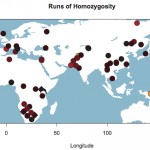
Clicks and Genes: Linguistic and Genetic Perspectives on Khoisan Prehistory
Science DOI: 10.1126/science.1227721 Genomic Variation in Seven Khoe-San Groups Reveals Adaptation and Complex African History Carina M. Schlebusch, Pontus Skoglund, Per Sjödin, Lucie M. Gattepaille, Dena Hernandez, Flora Jay, Sen Li, Michael De Jongh, Andrew Singleton, Michael G. B. Blum,…
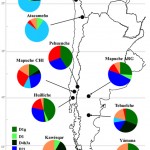
mtDNA from the South Cone of South America
PLoS ONE 7(9): e43486. doi:10.1371/journal.pone.0043486 An Alternative Model for the Early Peopling of Southern South America Revealed by Analyses of Three Mitochondrial DNA Haplogroups Michelle de Saint Pierre, Claudio M. Bravi, Josefina M. B. Motti, Noriyuki Fuku, Masashi Tanaka, Elena…

How Europeans Got to Be ~10% American Indian
Genetics doi: 10.1534/genetics.112.145037 Ancient Admixture in Human History Nick Patterson, Priya Moorjani, Yontao Luo, Swapan Mallick, Nadin Rohland, Yiping Zhan, Teri Genschoreck, Teresa Webster, and David Reich Population mixture is an important process in biology. We present a suite of methods…
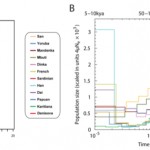
A High Coverage of the Denisovan Hominin
Science 30 August 2012 DOI: 10.1126/science.1224344 A High-Coverage Genome Sequence from an Archaic Denisovan Individual Matthias Meyer, Martin Kircher, Marie-Theres Gansauge, Heng Li, Fernando Racimo, Swapan Mallick, Joshua G. Schraiber, Flora Jay, Kay Prüfer, Cesare de Filippo, Peter H. Sudmant,…

Genetics and Linguistics of the Bantu Expansion
Proc. Roy. Soc. Lond. B 279: 3256-3263. doi: 10.1098/rspb.2012.0318 Bringing Together Linguistic and Genetic Evidence to Test the Bantu Expansion De Filippo, Cesare, Koen Bostoen, Mark Stoneking, and Brigitte Pakendorf. The expansion of Bantu languages represents one of the most momentous…

Social Anthropology and the Bantu Expansion
Razib is now officially a fantasy science blogger. When he recently called his readers “stupid, ignorant or lazy” and put up a stringent comments policy (I bet inspired by my own) rallying them to show their “A-game,” I knew it…

How to Interpret Patterns of Genetic Variation? Admixture, Divergence, Inbreeding, Cousin Marriage
Two different but important population genetics papers have come out. One is Steven Bray et al. (2010) “Signatures of Founder Effects, Admixture, and Selection in the Ashkenazi Jewish Population.” The other one is Isabel Alves et al. (2012) “Genomic Data…
Out-of-Africa in the Mid-Pleistocene: A New Interdisciplinary Paradigm or a New Myth?
In the comments section on this blog, Dienekes raises the issue of interdisciplinary support for the out-of-America theory. Since I’m a big proponent of interdisciplinarity, the seeming convergence of genetics, archeology and paleobiology on the origin of modern humans in…
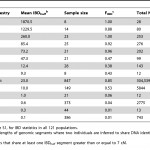
The Effect of Long-Term Endogamy on Identity-By-Descent
PLoS ONE 7(4): e34267. doi:10.1371/journal.pone.0034267 Cryptic Distant Relatives Are Common in Both Isolated and Cosmopolitan Genetic Samples Henn, Brenna M., Lawrence Hon, J. Michael Macpherson, Nick Eriksson, Serge Saxonov, Itsik Pe’er, Joanna L. Mountain. Although a few hundred single nucleotide…
Piraha Indians, Recursion, Phonemic Inventory Size and the Evolutionary Significance of Simplicity
Daniel Everett has a new book out that will surely stir more controversy around Piraha Indians, Chomskyan recursion and the evolution of human language. I haven’t read this book yet, but The Chronicle of Higher Education has an extensive coverage…
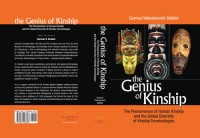

Recent Comments